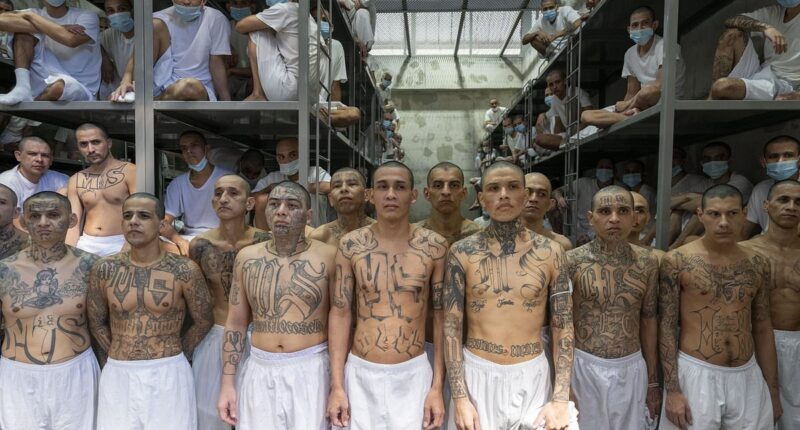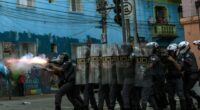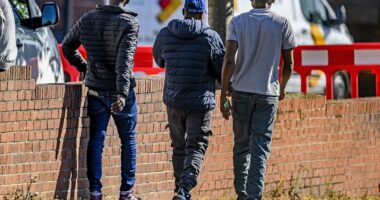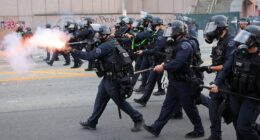
In stark images that were proudly shared by the government of El Salvador, we see lines of prisoners at CECOT who have been stripped and shaved, with only their tattoos to identify them.
CECOT, also known as the Terrorism Confinement Centre, plays a central role in Nayib Bukele’s aggressive measures against violent rival gangs that have plagued El Salvador and even parts of the United States where they originated.
Bukele’s administration has faced criticism from global leaders and human rights organizations for the inhumane conditions at CECOT, which have been likened to ‘concentration camp’ conditions – inadequate bedding, no contact with the outside world, lack of outdoor areas, absence of reading materials, and reports of physical abuse.
But Bukele defends his strongman approach as an effective way of deterring the most violent criminals. The Calle 18 gang earned itself the name ‘the Children’s Army’ for hiring elementary school-age children to carry out deeds, including killings.
MS-13 have been reported to have hacked a rival to death with a machete, allegedly carving out his heart in a stark warning to others. The victim was reportedly caught defacing their graffiti.
Such symbology is important to both groups, who adorn themselves with intricate tattoos all over their bodies, representing their allegiances, twisted moral codes and crimes. For CECOT staff and those manning the borders, understanding what they mean is crucial to understanding the gangs, their hierarchies and how they work.
With President Trump warning that violent gangs with ‘tattoos all over their faces’ are now pouring into America across the southern border, Bukele has offered to take in people deported from the U.S. to be housed in the 40,000-capacity mega-jail.
Prison director Belarmino Garcia explained to MailOnline how the tattoos hold hidden messages meant to signal loyalties, celebrate violence and intimidate enemy factions.
MS-13 and Calle 18 emerged in the wake of the El Salvadorian civil war, lasting from 1979 to 1992, as refugees fled to the United States for the hope of a better life.
When the war ended, many returned to their native country – including gangs forged on the streets of Los Angeles, bringing with them factional rivalry, violence and traditions.
Today, MS-13 (Mara Salvatrucha-13; is thought to have between 50,000 and 70,000 members around the world. Calle 18 (lit. 18th Street) is thought to have up to 65,000.
Both are in league with powerful gangs and mafias around the world, including the Mexican Mafia and the Sinaloa Cartel, and the Triads, respectively.
Over decades, thousands of members from both gangs have fought and died for the crown of Central America’s most powerful group, profiting off crimes such as sex and drug trafficking, racketeering, money laundering, extortion and kidnapping.
President Nayib Bukele claims the mega prison is the solution. In 2022, he declared a state of emergency that suspended the right to legal council and increased the time an arrested person can be held without charge – among other powers.
The 800 prison staff on site have the arduous tasks of preventing violence from breaking out, maintaining order by imposing brutal conditions that critics have deemed human rights ‘abuses on a large scale’. Some have died in custody.
Prison director Belarmino Garcia told MailOnline how staff learn to read tattoos for a quick biography of the kind of people they are dealing with.
‘Each tattoo has a meaning that describes their life and their gang past,’ he said. ‘They may describe how many they have killed. Often they will have the name of the place they used to operate.’
‘It used to be that senior gang members tattooed the faces of other members as punishment, when they did wrong and failed in their task,’ he said.
‘This was in the beginning. Now when you do something well or “good” for the gang you earn your tattoo.’
Devil Horns
The ‘devil horns’ hand sign adorning many MS-13 members has associated the group with Satanic practices over the years – a label the gangsters are seemingly not opposed to.
‘La Garra’ – the claws – traces its origins back to the gang’s humble beginnings in the 1970s, Thomas Ward, an anthropology professor at the University of Southern California, told the Washington Post.
Back then, the ‘Mara Salvatrucha Stoners’ were little more than a ragtag group of marijuana smokers who enjoyed heavy metal. Some took interest in Satanism.
‘These Satanists gave MSS its badass reputation for evil,’ Ward told the newspaper.
While many shied away from the gory animal sacrifice initiation rituals practiced by a deranged few, ‘they banked on their gang’s reputation for devil worship, which gave it and them an aura of mystery and terror’.
One early recruit told Ward how they were initiated by cutting their own hands with a knife and drinking the blood before smoking weed and ‘cutting open a cat’.
Over time, the group became more of a street gang offering protection to other Salvadorians newly arriving in the U.S. Members became hardened by prison, and the group made contacts within the Mexican Mafia.
What continued to set MS-13 apart was the association with Satanism, still passed down in the impressive iconography proudly displayed on members’ bodies.
The Devil’s head with a halo is understood to be the ‘official’ logo of the group.
The beast is my father…
An offshoot of the Satanic connection, one prisoner is seen with the tattoo ‘the beast is my father, the death is my mother’.
The clunky wording, transcribed in English, denotes the group’s enduring connection with English-speaking America.
With the devil included underneath, it also alludes back to both the group’s historic interest with Satanism and religious themes.
A more overt reference is the brandishing of 666. Inmates in CECOT present with the ‘number of the Beast’ across their foreheads.
The Virgin of Guadalupe
The Virgin of Guadalupe features prominently on several gang members inside the prison.
The title and imagery originated in Mexico nearly 500 years ago, and ties the gangs to their origins south of the American border.
The figure is based on a vision of Mary said to have appeared to locals four decades after Christopher Columbus first arrived in the New World.
Today, she the iconography of the ‘Patroness of Latin America’ and ‘Empress of the Americas’ appears in religious buildings across Mexico.
While MS-13 originated in LA, many members are Mexican and operate inside the country. Mexico provides lucrative opportunities to sell marijuana, crystal meth and cocaine, among other drugs, acting as a transit country for members destined for the U.S.
According to Insight Crime, the breakdown of a truce between gangs in 2015 saw a ‘wave of terrified homeboys fleeing El Salvador police’ welcomed in Mexico.
The Virgin of Guadelupe not only connects gang members with the country, but represents a higher power that faithful believe offers vital protection.
Others may prefer to show their connections to the United States through their tattoos. One of the inmates is seen with ‘Holliwood Gangster’ on their chest.
Speak no evil
The notion of Omertà, a code of silence, crops up throughout Mafia history, tracing back to the strong ties between Sicilians against foreign rule even before the emergence of Cosa Nostra.
Gangs around the world rely on trust in their colleagues, who could at any time bring down the organisation with the right tip-off, often offered immunity or shorter sentences for helping the authorities.
As such, tattoos signalling loyalty and commitment are commonplace for both Calle 18 and MS-13. Boastful and prominent markings symbolising a disregard for authority help bind gangsters to their life of crime.
One prisoner inside CECOT has a tattoo of a three clown faces, a take on ‘see no evil, speak no evil, hear no evil’. One covers its eyes, another has its fingers in its ears, and the third fingers to lips.
The tattoo is meant as a warning to keep quiet, Garcia explains.
Clowns
Clowns take on many different roles in gang tattoos.
Some of the prisoners wear clowns on opposite sides of their shoulders, one happy and one sad, to represent ‘Laugh now, cry later’.
Separately, clowns can be used to remember a fun moment, social researcher Jannette Aguilar told AFP.
Even these quite complicated tattoos are done with crude equipment outside of professional studios, often with sharpened objects like pens, blades and toothbrushes, by repeatedly puncturing the skin.
Engraved into the skin without anaesthetic, the more you have, the harder you are, they say.
Three dots
The three dots, a common prison tattoo easily marked with amateur equipment, is said to be shorthand for ‘Mi Vida Loca’, or ‘My Crazy Life’.
Often this appears near the eye or on the face in a triangular shape. Famously, the rapper Ice Cube dons the tattoo.
In some cases this could represent the Holy Trinity – the Son, the Father and the Holy Spirit in Christian tradition.
As such, it is mostly seen on Hispanic inmates.
Where possible, many gang members choose to sport tattoos of the words ‘My Crazy Life‘ written out in full.
Again, the prominence of the large tattoos is a binding commitment to the cause.
Variants like ‘Vamos Locos‘ – Let’s Go Crazy – also serve to intimidate rivals.
In the prison, one inmate was seen wearing both the three dots and a tattoo across his chest, ‘the life is a game‘ – an apparent word-for-word translation from Spanish.
Prayers
Hands clasped in prayer are another common symbol featured in gangland tattoos.
The representation is supposed to signify the phrase ‘Forgive me, my mother, for my crazy life’, according to an investigation by the Honduran newspaper El Heraldo.
Yin and Yang
The Chinese symbols of Yin and Yang find their origins in different Chinese philosophies, representing the supposed duality of all nature – good and evil, right and wrong, light and dark.
Different schools of thought teach that balance must be respected in all things.
This symbology has taken on a new meaning among Latin gang members, El Heraldo reports, with members using it to express how they have gone beyond conventional morality and the balance that exists between good and evil.
Teardrops
A tattoo of a teardrop has symbolic significance in prison communities around the world.
A simple tattoo to draw with prison equipment, it is supposed to represent either a murder or somebody the wearer has lost.
When the teardrop is empty, or done with just an outline, it represents either attempted murder – or plans for revenge.
XV3
A more straightforward representation, XV3 is one way of representing affiliation with the Calle 18 gang, also known as Barrio 18.
The XV is supposed to represent the number 15, in Roman numerals. With the three, it makes 18.
Other members in the prison are seen with much larger 18s on their backs, like a football shirt.
In another iteration, some have gang signs – made with their hands – tattooed onto their bodies, also shaped to look like an 18.
MS-13 members are seen with large 13s or ‘MS’.
One inmate is pictured with the word for ‘eighteen’ in Spanish across his chest – spelled incorrectly.
TLS
TLS appears to be shorthand for Teclas Locos Salvatruchos, a clique of the MS-13 gang in El Salvador.
The faction continues to operate across Latin America. El Salvador reported on February 7 that five TLS ‘adolescents in conflict with the law’ had been handed down sentences of up to 225 years for the crimes of ‘homicide, disappearance of persons, extortion, illegal occupation and illicit associations’.
The bodies of the murdered victims were found in what authorities called a ‘clandestine ceremony’.
The five named youths were all aged between 18 and 19.
Relationships
While many tattoos are used to denote professional affiliation, religion and other sectarian identities, personal relationships still feature prominently on gang members.
One of the inmates remembers a late ally or family member with ‘Rip Marvin Omar’.
Another, in the crowd, has a more sparsely decorated back, with space at the top reserved for ‘Stacy, Geraldine, Silvia’ and another name.
These could be sisters, daughters and a partner, or names of other significance to the man.
But all come underneath the first loyalty: XV3.
Another marks out space for a spouse or family member: Daniela.
Again, this comes second to XVIII etched in bold on the neck.

















